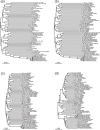Phylogenetic Characterizations of Highly Mutated EV-B106 Recombinants Showing Extensive Genetic Exchanges with Other EV-B in Xinjiang, China
- PMID: 28230168
- PMCID: PMC5322377
- DOI: 10.1038/srep43080
Phylogenetic Characterizations of Highly Mutated EV-B106 Recombinants Showing Extensive Genetic Exchanges with Other EV-B in Xinjiang, China
Abstract
Human enterovirus B106 (EV-B106) is a new member of the enterovirus B species. To date, only three nucleotide sequences of EV-B106 have been published, and only one full-length genome sequence (the Yunnan strain 148/YN/CHN/12) is available in the GenBank database. In this study, we conducted phylogenetic characterisation of four EV-B106 strains isolated in Xinjiang, China. Pairwise comparisons of the nucleotide sequences and the deduced amino acid sequences revealed that the four Xinjiang EV-B106 strains had only 80.5-80.8% nucleotide identity and 95.4-97.3% amino acid identity with the Yunnan EV-B106 strain, indicating high mutagenicity. Similarity plots and bootscanning analyses revealed that frequent intertypic recombination occurred in all four Xinjiang EV-B106 strains in the non-structural region. These four strains may share a donor sequence with the EV-B85 strain, which circulated in Xinjiang in 2011, indicating extensive genetic exchanges between these strains. All Xinjiang EV-B106 strains were temperature-sensitive. An antibody seroprevalence study against EV-B106 in two Xinjiang prefectures also showed low titres of neutralizing antibodies, suggesting limited exposure and transmission in the population. This study contributes the whole genome sequences of EV-B106 to the GenBank database and provides valuable information regarding the molecular epidemiology of EV-B106 in China.
Conflict of interest statement
The authors declare no competing financial interests.
Figures





Similar articles
-
Genetic characterization and molecular epidemiological analysis of novel enterovirus EV-B80 in China.Emerg Microbes Infect. 2018 Nov 28;7(1):193. doi: 10.1038/s41426-018-0196-9. Emerg Microbes Infect. 2018. PMID: 30482903 Free PMC article.
-
Phylogenetic characteristics and molecular epidemiological analysis of novel enterovirus EV-B83 isolated from Tibet, China.Sci Rep. 2020 Apr 20;10(1):6630. doi: 10.1038/s41598-020-63691-4. Sci Rep. 2020. PMID: 32313119 Free PMC article.
-
Phylogenetic evidence for multiple intertypic recombinations in enterovirus B81 strains isolated in Tibet, China.Sci Rep. 2014 Aug 12;4:6035. doi: 10.1038/srep06035. Sci Rep. 2014. PMID: 25112835 Free PMC article.
-
Isolation and Characterization of a Highly Mutated Chinese Isolate of Enterovirus B84 from a Patient with Acute Flaccid Paralysis.Sci Rep. 2016 Aug 8;6:31059. doi: 10.1038/srep31059. Sci Rep. 2016. PMID: 27499334 Free PMC article.
-
Circulation of two Enterovirus C105 (EV-C105) lineages in Europe and Africa.J Gen Virol. 2015 Jun;96(Pt 6):1374-1379. doi: 10.1099/vir.0.000088. Epub 2015 Feb 9. J Gen Virol. 2015. PMID: 25667329 Review.
Cited by
-
Molecular characterization of echovirus 12 strains isolated from healthy children in China.Sci Rep. 2018 Aug 6;8(1):11716. doi: 10.1038/s41598-018-30250-x. Sci Rep. 2018. PMID: 30082917 Free PMC article.
-
Antigenic characteristics and genomic analysis of novel EV-A90 enteroviruses isolated in Xinjiang, China.Sci Rep. 2018 Jul 6;8(1):10247. doi: 10.1038/s41598-018-28469-9. Sci Rep. 2018. PMID: 29980696 Free PMC article.
-
Genomic epidemiology of coxsackievirus A16 in mainland of China, 2000-18.Virus Evol. 2020 Nov 9;6(2):veaa084. doi: 10.1093/ve/veaa084. eCollection 2020 Jul. Virus Evol. 2020. PMID: 33343924 Free PMC article.
-
Genetic characterization and molecular evolution of type 3 vaccine-derived polioviruses from an immunodeficient patient in China.Virus Res. 2023 Sep;334:199177. doi: 10.1016/j.virusres.2023.199177. Epub 2023 Jul 24. Virus Res. 2023. PMID: 37479187 Free PMC article.
-
Phylogenetic analysis and phenotypic characterisatics of two Tibet EV-C96 strains.Virol J. 2019 Mar 29;16(1):40. doi: 10.1186/s12985-019-1151-7. Virol J. 2019. PMID: 30922336 Free PMC article.
References
-
- Picornaviridae Virus Taxonomy: Classification and Nomenclature of Viruses: Ninth Report of the International Committee on Taxonomy of Viruses. (Elsevier, San Diego, 2011).
Publication types
MeSH terms
Substances
LinkOut - more resources
Full Text Sources
Other Literature Sources

